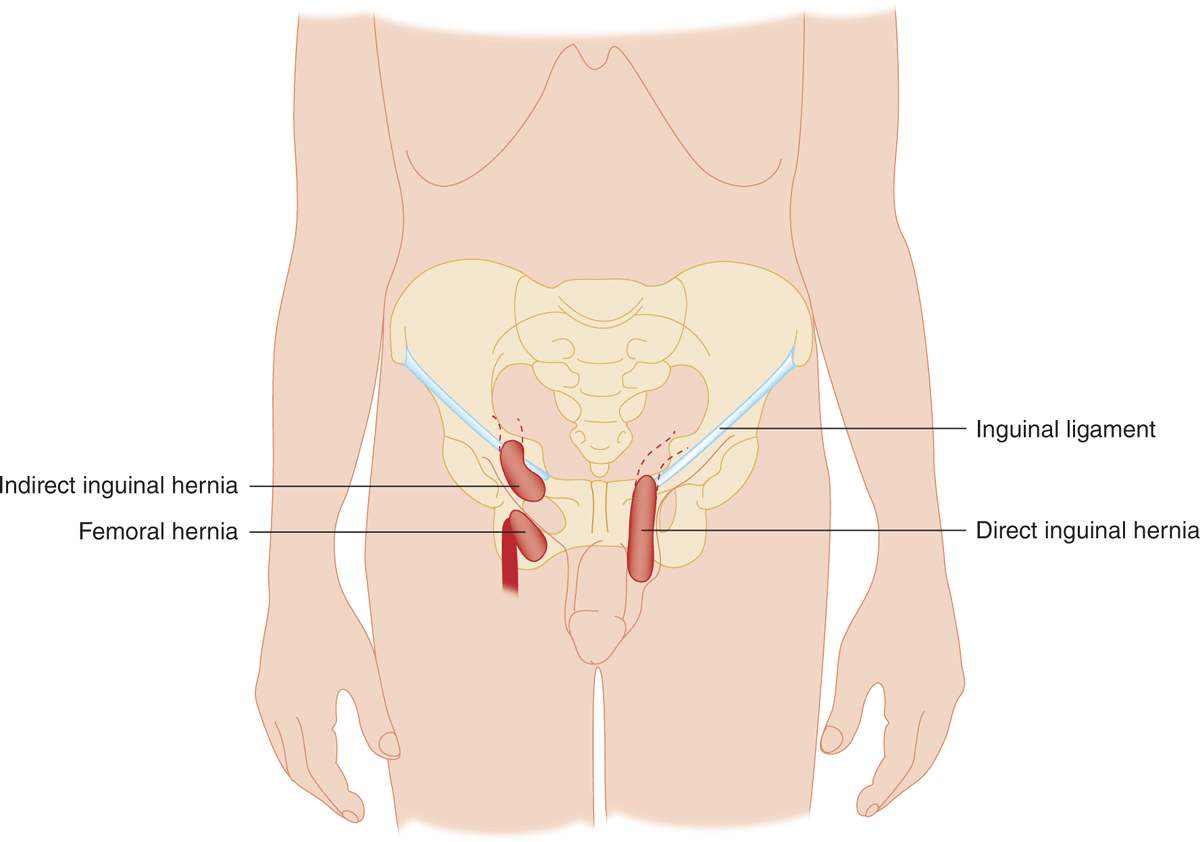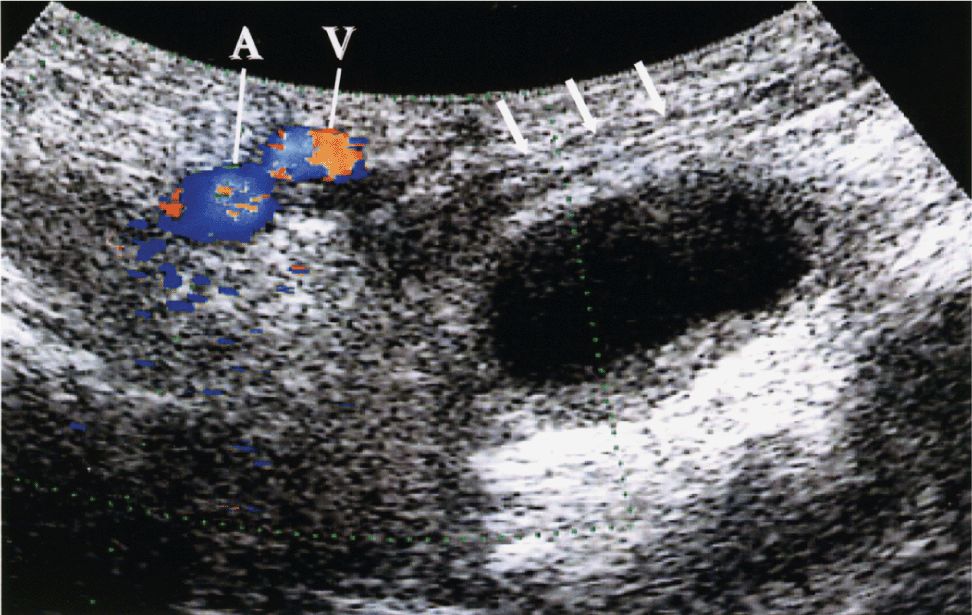Nearly 10% of the population develops a hernia during their lifetime.
![]() Hernias are classified by anatomic location, hernia contents, and the status of those contents (eg, reducible, incarcerated, or strangulated).
Hernias are classified by anatomic location, hernia contents, and the status of those contents (eg, reducible, incarcerated, or strangulated).
![]() The most common abdominal hernias are inguinal, ventral, and femoral hernias (Fig. 48-1).
The most common abdominal hernias are inguinal, ventral, and femoral hernias (Fig. 48-1).
![]() Seventy-five percent of all hernias are inguinal hernias, with two-thirds of these being indirect hernias. Although inguinal hernias occur more frequently in men, they are also the most common hernias in women. There is no gender predilection in ventral hernias, but femoral hernias occur much more commonly in women.
Seventy-five percent of all hernias are inguinal hernias, with two-thirds of these being indirect hernias. Although inguinal hernias occur more frequently in men, they are also the most common hernias in women. There is no gender predilection in ventral hernias, but femoral hernias occur much more commonly in women.
![]() Predisposing factors include family history, lack of developmental maturity, undescended testes, genitourinary abnormalities, conditions that increase intra-abdominal pressure (eg, ascites or pregnancy), and surgical incision sites.
Predisposing factors include family history, lack of developmental maturity, undescended testes, genitourinary abnormalities, conditions that increase intra-abdominal pressure (eg, ascites or pregnancy), and surgical incision sites.

PATHOPHYSIOLOGY
![]() Hernias occur in structural areas with inherent weakness, including penetration sites for extraperitoneal structures, areas lacking strong multilayer support, and wound sites (either surgical or traumatic).
Hernias occur in structural areas with inherent weakness, including penetration sites for extraperitoneal structures, areas lacking strong multilayer support, and wound sites (either surgical or traumatic).
![]() Specific hernia types include (1) direct inguinal hernias, which project directly through a weakness in the transversalis fascia in Hesselbach triangle; (2) indirect inguinal hernias, which pass through the internal inguinal ring and present as a groin mass upon exiting the external inguinal ring; (3) incisional hernias, which occur as a result of excess wall tension or inadequate wound healing and are associated with wound infections; (4) umbilical hernias, which commonly are seen in infants but can be found in adults as a result of conditions that increase intra-abdominal pressure; and (5) femoral hernias, which travel through the femoral canal and protrude below the inguinal ligament.
Specific hernia types include (1) direct inguinal hernias, which project directly through a weakness in the transversalis fascia in Hesselbach triangle; (2) indirect inguinal hernias, which pass through the internal inguinal ring and present as a groin mass upon exiting the external inguinal ring; (3) incisional hernias, which occur as a result of excess wall tension or inadequate wound healing and are associated with wound infections; (4) umbilical hernias, which commonly are seen in infants but can be found in adults as a result of conditions that increase intra-abdominal pressure; and (5) femoral hernias, which travel through the femoral canal and protrude below the inguinal ligament.
CLINICAL FEATURES
![]() Most hernias are detected on routine physical examination.
Most hernias are detected on routine physical examination.
![]() When the contents of a hernia can be easily returned to their original cavity by manipulation, the hernia is reducible.
When the contents of a hernia can be easily returned to their original cavity by manipulation, the hernia is reducible.
![]() A hernia becomes incarcerated when its contents are not reducible. Incarcerated hernias may lead to bowel obstruction and strangulation. Strangulation refers to vascular compromise of the incarcerated contents and is an acute surgical emergency. When not relieved, strangulation may lead to gangrene, perforation, peritonitis, and septic shock.
A hernia becomes incarcerated when its contents are not reducible. Incarcerated hernias may lead to bowel obstruction and strangulation. Strangulation refers to vascular compromise of the incarcerated contents and is an acute surgical emergency. When not relieved, strangulation may lead to gangrene, perforation, peritonitis, and septic shock.
![]() Symptoms other than a protruding mass include localized pain, nausea, and vomiting. Children may exhibit irritability and poor feeding.
Symptoms other than a protruding mass include localized pain, nausea, and vomiting. Children may exhibit irritability and poor feeding.
DIAGNOSIS AND DIFFERENTIAL
![]() Physical examination is the predominant means of diagnosis.
Physical examination is the predominant means of diagnosis.
![]() Laboratory testing has no reliable indicators; however, leukocytosis and acidosis may indicate ischemic bowel.
Laboratory testing has no reliable indicators; however, leukocytosis and acidosis may indicate ischemic bowel.
![]() An acute abdominal series can reveal signs of intestinal obstruction and free air if perforation is suspected.
An acute abdominal series can reveal signs of intestinal obstruction and free air if perforation is suspected.
![]() Ultrasonographic detection of hernias is operator and body habitus dependent, but can be helpful in pediatric and pregnant patients when radiation exposure is a concern (Fig. 48-2).
Ultrasonographic detection of hernias is operator and body habitus dependent, but can be helpful in pediatric and pregnant patients when radiation exposure is a concern (Fig. 48-2).

FIG. 48-2. Ultrasonographic hernia detection. An incarcerated obturator hernia is demonstrated deep in the femoral region. It locates posterior to the pectineus muscle (arrows) and medial to the femoral artery (A) and vein (V). Tintinall’s 7th edition. [Reproduced with permission from Ma OJ, Mateer JR, Blaivas M (eds): Emergency Ultrasound, 2nd ed. Copyright © 2008 The McGraw-Hill Companies, All rights reserved. Chapter 9, General Surgery Applications, Common Abnormalities, Incarcerated Hernia. Figure 9–16 Part D.]
![]() Computed tomography remains the best radiographic test for the evaluation of hernias.
Computed tomography remains the best radiographic test for the evaluation of hernias.
![]() The differential diagnosis of a groin mass includes direct or indirect hernia, testicular torsion, tumor, groin abscess, hydrocele, varicocele, and hidradenitis. In children, retracted or undescended testes may be mistaken for inguinal hernias.
The differential diagnosis of a groin mass includes direct or indirect hernia, testicular torsion, tumor, groin abscess, hydrocele, varicocele, and hidradenitis. In children, retracted or undescended testes may be mistaken for inguinal hernias.
EMERGENCY DEPARTMENT CARE AND DISPOSITION
![]() An attempt to reduce a recently incarcerated hernia should be made. If there is question of the duration of the incarceration, reduction should not be attempted so as to not introduce dead bowel into the abdomen. General surgery should be consulted immediately.
An attempt to reduce a recently incarcerated hernia should be made. If there is question of the duration of the incarceration, reduction should not be attempted so as to not introduce dead bowel into the abdomen. General surgery should be consulted immediately.
![]() Emergent surgical intervention is the treatment of choice for incarcerated hernias that cannot be reduced or are strangulated. Patients should be made NPO, have intravenous fluid resuscitation, and receive adequate analgesia. Broad-spectrum antibiotics, such as cefoxitin 2 grams IV or piperacillin/tazobactam 3.375 grams IV, are indicated if there is evidence of perforation or strangulation.
Emergent surgical intervention is the treatment of choice for incarcerated hernias that cannot be reduced or are strangulated. Patients should be made NPO, have intravenous fluid resuscitation, and receive adequate analgesia. Broad-spectrum antibiotics, such as cefoxitin 2 grams IV or piperacillin/tazobactam 3.375 grams IV, are indicated if there is evidence of perforation or strangulation.
![]() In adults with reducible hernias, refer for outpatient surgical evaluation and repair. Signs of obstruction should be discussed and patients should return to the emergency department if the hernia cannot be reduced promptly.
In adults with reducible hernias, refer for outpatient surgical evaluation and repair. Signs of obstruction should be discussed and patients should return to the emergency department if the hernia cannot be reduced promptly.
![]() Infants with inguinal hernias have a high risk of incarceration and should be referred for surgical repair within 24 to 72 hours. In contrast, umbilical hernias in children are common, and immediate treatment is not recommended unless there is evidence of obstruction or incarceration. Refer these patients to their primary care providers for longitudinal follow-up. Refer children older than 4 years or children with hernias greater than 2 cm in diameter to a surgeon.
Infants with inguinal hernias have a high risk of incarceration and should be referred for surgical repair within 24 to 72 hours. In contrast, umbilical hernias in children are common, and immediate treatment is not recommended unless there is evidence of obstruction or incarceration. Refer these patients to their primary care providers for longitudinal follow-up. Refer children older than 4 years or children with hernias greater than 2 cm in diameter to a surgeon.
Stay updated, free articles. Join our Telegram channel

Full access? Get Clinical Tree



